How to Catch a Reader: Make Up Cool (Fibs) Stuff! • by Natascha Biebow
 From Calvin & Hobbes by Bill WatersonCan you tell the truth from a bunch of made-up imaginings, er . . . fibs, when someone is spinning a really good yarn? Do your stories masquerade as believable ‘truths’?
From Calvin & Hobbes by Bill WatersonCan you tell the truth from a bunch of made-up imaginings, er . . . fibs, when someone is spinning a really good yarn? Do your stories masquerade as believable ‘truths’? One of the most admired qualities of storytellers is their amazing ability to convince readers that their yarns could be true, and maybe really ARE true . . .
This is because the premise and their characters are believable, which makes readers want to go the story’s journey. And, in doing so, they are helping readers to figure out some important stuff about their world.
Take REALLY REALLY by Kes Gray and Nick Sharratt:
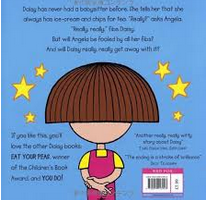
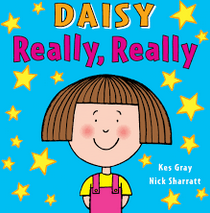
When Daisy gets a babysitter for the first time, she eats her mum's note and tells the her sitter all kinds of more and more elaborate fibs – testing, testing, but also working her way through this new experience. All the while, her fingers are safely crossed behind her back!
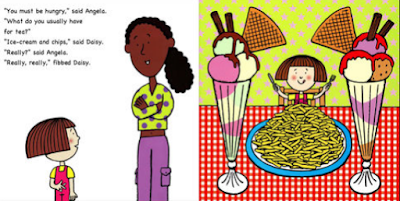 From Really, Really by Kes Gray and Nick Sharratt
From Really, Really by Kes Gray and Nick Sharratt In OLIVIA SAVES THE CIRCUS by Ian Falconer, Olivia is invited by her teacher to tell the class about her holiday.
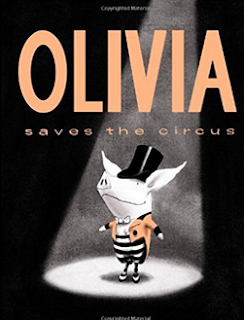
The story starts innocuously enough – Olivia’s mum took her and her brother to the circus. But then . . .
. . . the circus people were off sick and only Olivia could do all the acts!
She was Olivia the Tattooed Lady, Olivia the Lion Tamer, Olivia the Tight-rope Walker, the Clown, and Olivia the Queen of the Trampoline, and Madame Olivia and her trained dogs. She was FAMOUS!
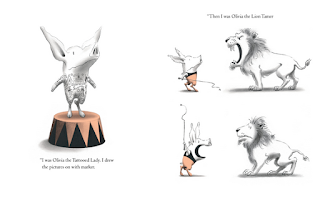 From Olivia Saves the Circus by Ian Falconer
From Olivia Saves the Circus by Ian Falconer
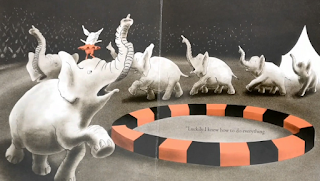 From Olivia Saves the Circus by Ian Falconer
From Olivia Saves the Circus by Ian Falconer Olivia’s teacher is skeptical. “Are you sure, Olivia?”
“To the best of my recollection.”
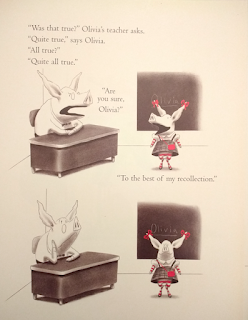 From Olivia Saves the Circus by Ian Falconer
From Olivia Saves the Circus by Ian Falconer Her deadpan response is of course what makes the story humorous, however, it is also a beautifully observed picture of the lying game.
So why do children (and grown-ups) tell fibs and stories?
Young children can’t actually tell the difference between a fact and a lie until they are around two years old. This is because they don’t have the ability to get into another person’s shoes yet. The first lies they learn to tell are those where they say they deny doing something.
From the age three, young children also begin to tell white lies, such as to hide a surprise or to thank someone for a present even when they don’t really like it.
Take the classic NO ROSES FOR HARRY by Gene Zion and Margaret Blog Graham.
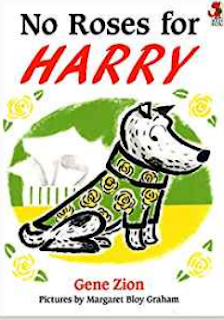
Harry is a white dog with black spots. On his birthday, he is given a lovely homemade jumper from Grandma. But it has roses on it. “It was the silliest sweater he’d ever seen.”
 From No Roses for Harry by Gene Zion and Margaret Bloy Graham
From No Roses for Harry by Gene Zion and Margaret Bloy GrahamTHE LIE: It wouldn’t do to tell Grandma. Harry wears the sweater dutifully, but he’s sure the other dogs will laugh at him.
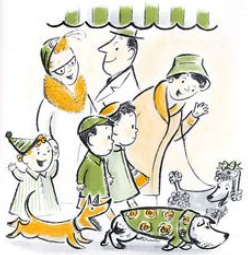 From No Roses for Harry by Gene Zion and Margaret Bloy Graham
From No Roses for Harry by Gene Zion and Margaret Bloy GrahamEventually, the sweater unravels and a bird makes a nest out of the wool. Harry doesn't tell anyone.
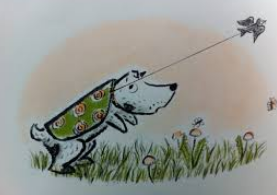 From No Roses for Harry by Gene Zion and Margaret Bloy GrahamBut then: disaster! Grandma is coming to visit!
From No Roses for Harry by Gene Zion and Margaret Bloy GrahamBut then: disaster! Grandma is coming to visit!
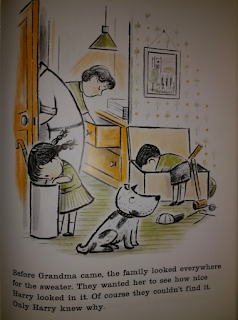 From No Roses for Harry by Gene Zion and Margaret Bloy Graham
From No Roses for Harry by Gene Zion and Margaret Bloy Graham THE SORT-OF-TRUTH: Harry feels compelled to show Grandma what’s become of the sweater (she thinks Harry has been incredibly generous). Best of all, at Christmas, Harry gets a new sweater – white with black spots. This time, he loves it!
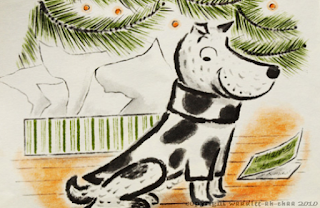 From No Roses for Harry by Gene Zion and Margaret Bloy GrahamBeing able to tell a fib or a believable story is often a way in to becoming socially acceptable, on the finely balanced scales of weighing up right and wrong. It’s also a sign that children are developing important cognitive skills such as ‘theory of mind’, the ability to recognize that others have different beliefs or feelings than they do, which develops slowly in the preschool and kindergarten years.
From No Roses for Harry by Gene Zion and Margaret Bloy GrahamBeing able to tell a fib or a believable story is often a way in to becoming socially acceptable, on the finely balanced scales of weighing up right and wrong. It’s also a sign that children are developing important cognitive skills such as ‘theory of mind’, the ability to recognize that others have different beliefs or feelings than they do, which develops slowly in the preschool and kindergarten years.In Sarah McIntyre's poignant story THE NEW NEIGHBOURS
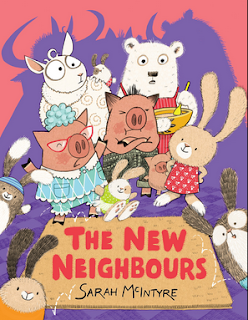
the whole tower block is convinced that the rats who have moved into the ground floor are "big, dirty, thieveing, dangerous rats" before they have even met them . . .
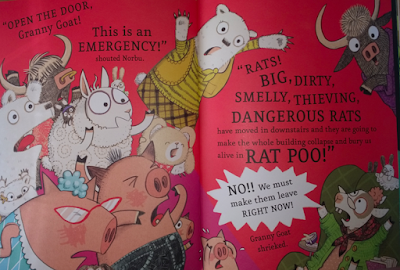 From The New Neighbours by Sarah McIntryeBut when they finally get to meet the pair of tiny, neat and friendly new neighbours in person, the friends are hugely embarrassed by the rats' kind invitation to come in and share CAKE. Lettuce doesn't want to admit the crazy stories they'd made up, so she fibs:
From The New Neighbours by Sarah McIntryeBut when they finally get to meet the pair of tiny, neat and friendly new neighbours in person, the friends are hugely embarrassed by the rats' kind invitation to come in and share CAKE. Lettuce doesn't want to admit the crazy stories they'd made up, so she fibs: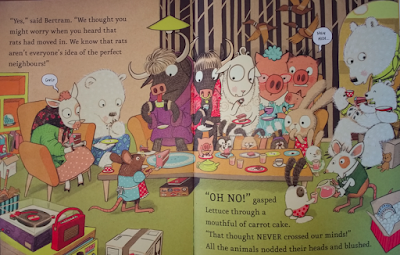 From The New Neighbours by Sarah McIntrye
From The New Neighbours by Sarah McIntrye So, if I’m a writer, can I fib as much as I like? Will I be believed?
In John Burningham’s JOHN PATRICK NORMAN McHENNESSY, THE BOY WHO WAS ALWAYS LATE, the lines between what is true and what is a fib are seemingly clear until the tables are turned and the grown-up teacher fibs. Or is it everything John has been saying really The Truth?
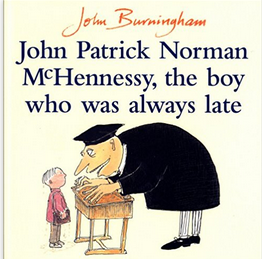
John Patrick Norman McHennessy spins all kinds of yarns to convince his teacher why he is late for school. He has met a crocodile, a lion and even a tidal wave! Of course, his teacher does not believe him.
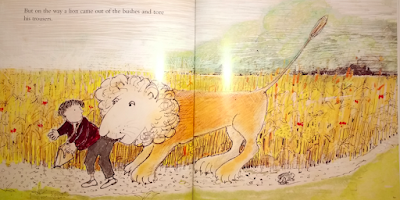 From John Patrick Norman McHennessy by John Burningham
From John Patrick Norman McHennessy by John Burningham But when his teacher is captured by a big hairy gorilla, John replies there are no such things as big hairy gorillas. Who’s telling what truth and what is the fib?
I would venture that telling made-up ‘truths’ is something authors are wired to do. As I tell stories, I reach back into my past, I tell about encounters and observations from last week and dig deep for tales inspired by my childhood. I embroider. My stories are inspired by where I’ve been and where I want to go, and this helps me find my bearing on what is true for me today. By telling stories, I am making something ‘real’, even if it’s a big fat fib, conjuring it up in my mind’s eye.
We tell stories about things we need to be true.
We tell stories about things we wish were true.
We tell stories to avoid punishment or consequences.
Lying requires the child to hide the truth, plan up a storyabout it, tell someone about it, and remember it! So, we began practising our storytelling ‘lying’ skills right from when we're preschoolers.
Of course, as children get older they also develop their moral compass, so they can distinguish between right and wrong, what is made-up and what is true. They are encouraged to tell the truth.
Like in THE TRUTH ACCORDING TO ARTHUR, where Arthur tells all kinds of alternative versions of what really happened when he borrowed his brother’s big bike, accidentally wrecked it and scratched Mum’s car.
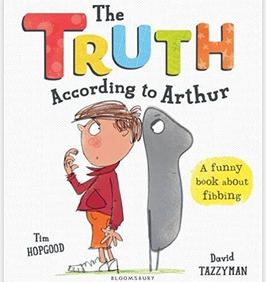
An alien did it! . . . A super cool princess borrowed the bike!
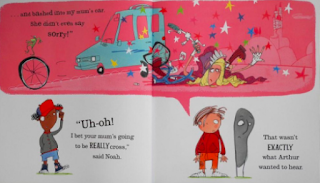 From The Truth According to Arthur by Tim Hopgood and David Tazzyman
From The Truth According to Arthur by Tim Hopgood and David Tazzyman The bike was really a robot! . . .
 From The Truth According to Arthur by Tim Hopgood and David Tazzyman
From The Truth According to Arthur by Tim Hopgood and David Tazzyman Arthur tries bending, stretching, disguising it, hiding, and ignoring The Truth . . . But eventually, when Mum asks what has happened, Arthur looks The Truth straight in the eye and confesses. It’s not nearly as interesting as the stories he was telling, but Mum is pleased he told The Truth.
A fun game I like to play is to imagine what the world will be like in the future. Will it be one where we can fly everywhere rather than use a car on a road? Wouldn’t it be spectacular if I could just go and see my mum in Brazil for a cup of tea and then be back in London in time for dinner? Will robots deliver our post?
If I can’t tell a story or a weensy-fib-imagined truth, I can’t invent the future. If I can’t imagine what we might invent to fill the gaps in our world, to solve our current problems, then I might be powerless to change anything. Stories help young readers feel empowered to imagine and to make stuff up.
When a story resonates, the reader will nod and say, “Yes, that’s true! Now listen to what happened when . . ." and tell his or her version of this ‘truth’. And so we are all linked by a circle of fibs, a circle of stories. (But we should really tell The Truth.)
_________________________________Natascha Biebow, MBE, Author, Editor and Mentor
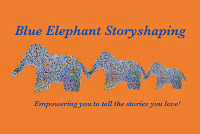 Natascha is the author of The Crayon Man (coming in 2019), Elephants Never Forget and Is This My Nose?, editor of numerous award-winning children’s books, and Co-Regional Advisor (Co-Chair) of SCBWI British Isles. She runs Blue Elephant Storyshaping, an editing, coaching and mentoring service aimed at empowering writers and illustrators to fine-tune their work pre-submission. Check out her Cook Up a Picture Book courses!
Natascha is the author of The Crayon Man (coming in 2019), Elephants Never Forget and Is This My Nose?, editor of numerous award-winning children’s books, and Co-Regional Advisor (Co-Chair) of SCBWI British Isles. She runs Blue Elephant Storyshaping, an editing, coaching and mentoring service aimed at empowering writers and illustrators to fine-tune their work pre-submission. Check out her Cook Up a Picture Book courses!
Published on May 13, 2018 19:00
No comments have been added yet.



